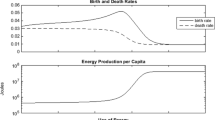Abstract
The major distinctive feature of cultural goods is that consumers must learn how to consume them, implying that preferences should be modelled as intertemporally dependent. The canonical model in the literature uses a habit formation analogy. In this paper, we discuss in detail, though in the simplest setup, a consistent preference structure for that model. Then, we derive the implications for the dynamics of two aggregate equilibrium models, a fixed price model and a flexible price model. The learning-by-consuming behaviour is characterised by a preference structure displaying bounded adjacent complementarity in the demand for the cultural good. This implies that there will be short run complementarity between the stocks of culture and financial wealth and that the adjustment of the demand for cultural goods, or of their relative price, will have some inertia. In the exogenous price model, we find that increases in income will raise the long run demand for cultural goods while increases in the relative price will decrease it. In the endogenous price model, an increase in the supply of cultural goods will imply an initial undershooting of the price of cultural goods followed by an upward transition process. Our results seem to be consistent with the empirical results on the demand for cultural goods and seem to offer an explanation for the Baumol and Bowen paradox.
Similar content being viewed by others
References
Becker, G.S. and Murphy, K.M. (1988) “A Theory of Rational Addiction.” Journal of Political Economy 96(4): 675–700.
Brito, P. (1997) “Local Dynamics for Planar Optimal Control Problems: A Complete Characterization.” Banco de Portugal, Research and Statistics Department, Working Paper WP 1–97.
Carroll, C. (2000) “Solving Consumption Models with Multiplicative Habits.” Economic Letters 68: 67–77.
Carroll, C., Overland, J., and Weil, D. (1997) “Comparison Utility in a Growth Model.” Journal of Economic Growth 2: 339–367.
Champarnaud, L. (1997) “Addiction with Non-Concave Objective Functions.” Unpublished manuscript.
Frey, B.S. (2000) Arts and Economics. Analysis and Cultural Policy, Springer-Verlag.
Gapinski, J. (1976) “The Lively Arts as Substitutes for Lively Arts.” American Economic Review 76: 20–25.
Gérard-Varet, L.-A. (1995) “On Pricing the Priceless: Comments on the Economics of the Visual Art Market.” European Economic Review 39: 509–518.
Heilbrun, J. and Gray, Ch. (1993) The Economics of Art and Culture. An American Perspective, Cambridge University Press.
Lucas, R. (1988) “On the Mechanics of Economic Development.” Journal of Monetary Economics 22(1): 3–42.
Mansoorian, A. (1993) “Habit Persistence and the Harberger-Laursen-Metzler Effect in an Infinite Horizon Model.” Journal of International Economics 34(1/2): 153–166.
Mansoorian, A. (1998) “Habits and Durability in Consumption, and the Dynamics of the Current Account.” Journal of International Economics 44: 69–82.
McCain, R. (1995) “Cultivation of Taste and Bounded Rationality: Some Computer Simulations.” Journal of Cultural Economics 19(1): 1–15.
McCain, R.A. (1979) “Reflections on the Cultivation of Taste.” Journal of Cultural Economics 3(1): 30–52.
McCain, R.A. (1981) “Cultivation of Taste, Catastrophe Theory and the Demand for Works of Art.” American Economic Review 71(2): 332–334.
Ryder, H.E.J. and Heal, G.M. (1973) “Optimal Growth with Intertemporally Dependent Preferences.” Review of Economic Studies 40(1): 1–32.
Scandizzo, P. (1992a) “Beauty, Satisfaction and Intrinsic Values.” Technical Report, Autumn Seminar of ICARE, Venezia.
Scandizzo, P. (1992b) “Cultural Goods and Economic Growth.” Ricerche Economiche 46(1–2): 91–110.
Stigler, G. and Becker, G. (1977) “De Gustibus non est Disputandum.” American Economic Review 67(1): 76–90.
Throsby, D. (1990) “Perception of Quality in the Demand for Theatre.” Journal of Cultural Economics 14: 65–82.
Throsby, D. (1994) “The Production and Consumption of the Arts: A View from Cultural Economics.” Journal of Economic Literature 32: 1–29.
Uzawa, H. (1965) “Optimal Technical Change in an Aggregative Model of Economic Growth.” International Economic Review 6: 12–31.
Wan, H.Y., Jr. (1970) “Optimal Saving Programs under Intertemporally Dependent Preferences.” International Economic Review 11(3): 521–547.
Author information
Authors and Affiliations
Corresponding author
Additional information
JEL Classification: Z1, E21
Rights and permissions
About this article
Cite this article
Brito, P., Barros, C. Learning-by-Consuming and the Dynamics of the Demand and Prices of Cultural Goods. J Cult Econ 29, 83–106 (2005). https://doi.org/10.1007/s10824-005-1748-0
Issue Date:
DOI: https://doi.org/10.1007/s10824-005-1748-0




